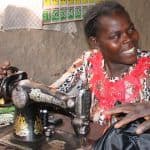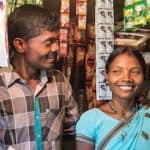Faster, Lighter Touch and Group-based: A Different Approach to Poverty Graduation
Helping people living in extreme poverty develop sustainable livelihoods is a global priority, but policymakers, funders, and individual donors are faced with competing ideas about the best way to achieve it. With over 760 million people living on less than $1.90 a day and over half living in sub-Saharan Africa, it is more important than ever that we show that money spent to fight global poverty brings results at scale.
Microenterprise development is one viable approach for helping ultra-poor families develop livelihoods, but some interventions that policymakers had hoped would help — such as microloans — have not proven effective in sustainably increasing the incomes of people living in extreme poverty.
One approach that has recently shown greater promise in helping the ultra-poor develop sustainable livelihoods across contexts is the graduation model. Graduation programs provide a time-bound sequence of interventions that includes a cash or asset transfer, training, on-going mentoring and access to savings and financial services. But graduation, at least how it is commonly practiced, is expensive. According to Innovations for Poverty Action, “measured effects are quite diverse and current implementations are expensive and very high touch, which raises the question about the drivers of effects, and whether they continue to be present as such programs get promoted to larger scale.”
To address some of these concerns, Innovations for Poverty Action and Village Enterprise (the organization I represent) recently completed a large-scale household randomized controlled trial (RCT). It tested Village Enterprise’s more streamlined, group-based graduation program to understand how it stands up to the current model, and thus could scale at a lower cost and with greater fidelity A third-party RCT is considered the gold standard of evidence in the social sciences and is rarely undertaken by organizations of Village Enterprise’s size.
Working exclusively in rural, remote areas of sub-Saharan Africa, Village Enterprise is providing very poor households a combination of cash transfers, mentorship, business and financial literacy training, and support for the formation of savings groups over a one-year period. The goals of the program are to help ultra-poor households in rural Africa develop sustainable livelihoods, increase income and savings, and build a brighter future for the next generation.
What differentiates the Village Enterprise graduation program is its shorter, lighter touch and group-based engagement. We start three-person businesses and deliver training through business savings groups of 30. The program is limited to one year, as opposed to two to three years in previously studied graduation programs. As a result, the program costs roughly a third of the least costly graduation programs evaluated in the six-country Science study. This lower cost is particularly notable given the remote and rural context in which Village Enterprise implements its program, as transportation is one of the major costs of implementing graduation programs in rural areas.
When we developed the RCT’s design, we were eager to test not only the Village Enterprise program but to also understand how the individual components drive impact. We used a community-based participatory process (participatory wealth ranking) to identify the poorest 6,378 households across 138 villages in rural Uganda. Researchers then randomly assigned eligible households to one of six groups: the full Village Enterprise graduation program, a variation of the full program called Business-in-a-Box (assets rather than a cash transfer), the Village Enterprise program minus the savings group, unconditional cash transfers, unconditional cash transfers combined with a behavioral/mindset intervention, or a control group for comparison purposes. And for the sake of transparency and learning, we made the RCT public from the onset so that the results would inform the poverty alleviation sector regardless of the outcome.
IPA recently published these key findings in a preliminary results brief:
- Village Enterprise’s microenterprise development program led to increased consumption, assets, and income, as well as improvements in nutrition and subjective well-being.
- Cost-effectiveness of Village Enterprise’s full program appears high: Researchers estimate a full cost recovery within three to four years.
- A cost-equivalent cash transfer appeared to have less promising medium-term impacts on poverty reduction and subjective well-being than the Village Enterprise microenterprise program, though estimates are more ambiguous.
- Adding a light-touch behavior change component to the cash transfer changed the investment patterns of cash transfer recipients and improved subjective well-being somewhat, but cannot be characterized as a substitute for the training and mentorship interventions of the microenterprise program.
- Overall, the results suggest that training and mentorship components of integrated poverty alleviation programs are sensible and cannot simply be removed (or substituted for cash transfers). But as they are complex, more research is needed on the issue of scaling them while maintaining their quality.
According to Nathanael Goldberg, director of IPA’s Social Protection Program and a co-author of the 2015 Science paper, “this research helps fill in an important piece of the puzzle in learning how to design scalable programs, showing streamlined approaches to graduation programming can benefit the extreme poor.”
But this RCT is just the start for Village Enterprise. We are committed to continuing to develop evidence that can help influence policy decisions so that resources are allocated wisely. Based on the strength of this RCT’s evidence, Village Enterprise was selected as the service provider for the first Development Impact Bond (DIB) for poverty alleviation in sub- Saharan Africa.
Village Enterprise and Instiglio, a pioneer in results-based financing, are partnering with the world’s two largest development agencies, U.S. Agency for International Development (USAID) and the U.K. Department for International Development (DFID) as outcome funders, with impact investors providing the working capital. Outcomes measurements include increases in consumption (as a proxy for income) and net assets. The DIB RCT will be conducted by IDinsight and the RCT design is already well under way. Global Development Incubator (GDI) will serve as the trustee of the outcome fund, which marks the first time a DIB has included such a role. As Trustee, GDI serves as the central “clearinghouse,” and will hold outcome payers’ funds in escrow until agreed-upon outcomes are verified through the DIB RCT. (Read more about this effort here).
This unique payment-for-results model provides a guarantee that donor money will be linked to meaningful improvements in poverty alleviation outcomes and requires funders to pay back Village Enterprise and its investors only if outcomes are met. It will also allow us to test larger cash transfers as well as continue to improve our program based on evidence.
Our longer-term goal is to scale this demonstration DIB by growing the outcomes fund so that it can serve more donors, investors and service providers that wish to achieve results in poverty alleviation. If we are successful, we hope that more resources will be mobilized to cost-effectively eliminate extreme poverty.
Dianne Calvi is CEO of Village Enterprise.
Photo courtesy of Village Enterprise
- Categories
- Investing



